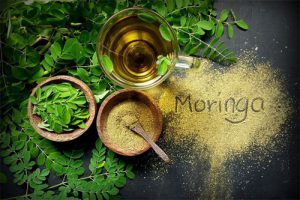Moringa is known as “the miracle tree” and supports health in numerous ways
Dating back to ancient Ayurvedic textbooks written in Sanskrit, Moringa is often regarded in traditional medicine as a miracle tonic and has been called “the miracle tree.” Western culture has a lot to learn from this small yet nutrient dense tree.
 Today we are going to go beyond the known facts that you may have heard about Moringa and get into the nitty gritty details of past traditions and usage.
Today we are going to go beyond the known facts that you may have heard about Moringa and get into the nitty gritty details of past traditions and usage.
What is moringa?
Also known as ‘drumstick tree’ or ‘ben oil tree’, Moringa is a very nutrient dense plant that has been praised for its health benefits for thousands of years. Scientists in the past decade have only started to uncover much of the reputed health benefits.
Native to Northwestern India, it has long been hailed to treat over 300 conditions ranging from fertility to digestion, and everything in between. Many people may not be aware, but there are actually 3 different varieties of the plant, including the black, white, and red varieties. Traditional usage includes using the raw flowers in culinary dishes or in a tea, but most supplements today use the powdered form.
Magnificent moringa dishes
In Bangladesh, moringa is used in curry dishes combined with poppy seeds, coconut and mustard. Often times it is boiled to then be consumed without any extra cooking or processing.
Korko, a Cambodian vegetable soup, utilizes moringa since most families grow these trees close to their residences. Moringa makes for a great salad or vegetable dish, alongside coriander in the case of native Cambodians.
In the Maldives, people eat this food as a breakfast during Ramazan, commonly combined with dried and fried tuna chips, onions, and dried chiles.
The deep Indian history of the moringa tree makes it a mainstay in both India and Pakistan, often boiled, cooked and then mashed. Other countries make regular use of moringa in their meals, including Thailand, the Philippines, Jamaica and More.
As you can see, western society has yet to evolve our eating in the way of incorporating health foods like Moringa, making it an important food to supplement.
Amazing moringa benefits
There is no shortage of nutrition when it comes to Moringa; in fact, it could be regarded as the most nutritious plant ever discovered on Earth. Each constituent of the plant has found uses in traditional medicine and daily intake can help you meet any nutritional deficits.
Moringa contains concentrated amounts of bio-available active elements including quercetin, chlorogenic acid, vitamin A, vitamin B1, vitamin B2, vitamin B3, vitamin B6, vitamin B7, vitamin C, vitamin D, vitamin E, and vitamin K. Moringa combines vitamins with all 9 essential amino acids, making it a complete protein source.
Moringa seeds and leaves are rich in sulfur-containing compounds called glucosinolates which are known to promote healthy microbial levels by inhibiting the growth of pathogenic microorganisms. These compounds are normally found in cruciferous veggies, making moringa even more useful to detoxify the body on a cellular level.
Polyphenols found in moringa leaves have potent circulatory effects, which may enhance blood flow by increasing nitric oxide production and promoting normal blood pressure levels. These plant compounds function by inhibiting key enzymes linked to high levels of blood pressure and decreased nitric oxide production.
From an athletic perspective, moringa can help cleanse the blood to allocate more nitric oxide production during workouts. Combine that with the glucosinolates found in moringa which break down into biologically active compounds like indole-3-carbinol to stimulate detoxifying enzymes in the gut and liver to help regulate estrogen activity in the body and maintain balanced hormones.
Studies show that extracts from moringa leaves and seeds may lower blood sugar levels by either increasing insulin production or the uptake of sugar into cells. Chlorogenic acids and isothiocyanates found in moringa could explain why traditional moringa dishes help with post-meal blood sugar levels.
yogaesoteric
March 29, 2021
Also available in:
 Français
Français
